Navigate to ... Summer 2024 | Summer 2023 | Summer 2022 | Summer 2021 | Summer 2020
Summer 2024 | back to top
Stony Brook, NY, August 13 - September 12, 2024 - A new video series on beach and water safety series, created by Illinois-Indiana Sea Grant and its partners, focuses on Lake Michigan. However, many of the lessons shared can be applied to the other Great Lakes, including Lakes Ontario and Erie, both of which have shorelines in upstate New York: nyseagrant.info/beachwatersafetyseries.
In addition to the tips you'll learn through the series, you can also find how best to stay safe while swimming this summer via #BEachSAFEly, the most recent round of posts for which were first filed in 2023.
Summer 2023 | back to top
Stony Brook, NY, July 3 - September 7, 2023 - Sea Grant's #BEachSAFEly launches its fourth summer season with a season long collection of social media posts being shared on Facebook, Twitter and Instagram by New York Sea Grant and New Jersey Sea Grant.
This season’s #BEachSAFEly posts, which focus on standard "ocean hazards" tips, build upon ones sent during the 2020—2022 summer seasons of this award-winning (Folio Award; APEX) campaign.
You can engage with our #BEachSAFEly posts (like, comment, share) on Facebook, Twitter, and Instagram.
Navigate to ... Week 1: Post 1 | Week 1: Post 2 | Week 2 | Week 3 | Week 4 | Week 5 | Week 6 | Week 7 | Week 8 | Week 9 | Week 10
Week 1, Post 1: Break the Grip of the Rip | back to top

While swimming this summer, be prepared if you need to "Break the grip of the rip" ...
Rip currents are one of the deadliest beach hazards. They occur as ocean water moves swiftly away from the shore.
If caught in a rip, remain calm! You will not be pulled under water. Wave or call for help, flip onto your back and float; rather than fighting against the current, follow it as it dissipates and takes you to calmer waters. Then, you can swim safely to shore.
If you notice someone in danger, do not try to save them by yourself – rather, maintain visual contact with the victim and send another beachgoer to get help, or call 9-1-1.
Week 1, Post 2: "Share the Beach with Wildlife" | back to top
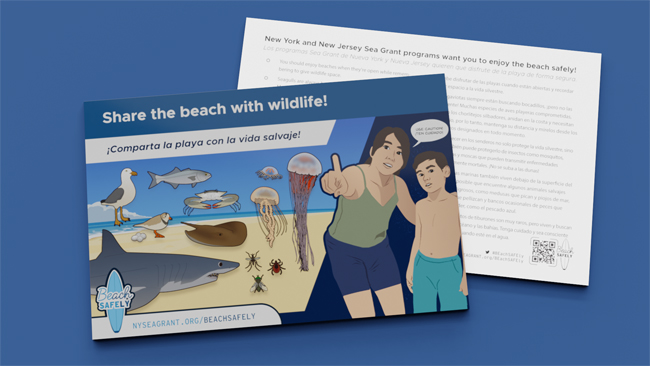
Remember to #BEachSAFEly this summer and "Share the Beach with Wildlife" …
• You should enjoy beaches when they're open while remembering to give wildlife space.
• Seagulls are always hunting for snacks, but do not feed them! Many species of engaged shorebirds like piping plovers nest along the shore and need space so please keep your distance and view them from designated trails at all times.
• Staying on the trails not only protects wildlife but can protect you from bugs such as mosquitos, ticks, and flies that can carry possibly fatal diseases. Do not climb on the dunes!
• Sea creatures also live below the ocean’s surface. You may encounter some hazardous sea wildlife like stinging jellyfish and sea lice, pinching crabs, and occasional schools of fish that can bite, like bluefish.
• Shark sightings are very rare, but they do live and hunt for food in the ocean and bays. Please use caution and be aware of your surroundings when in the water.
Week 2: "Pay Attention to Lifeguards" | back to top
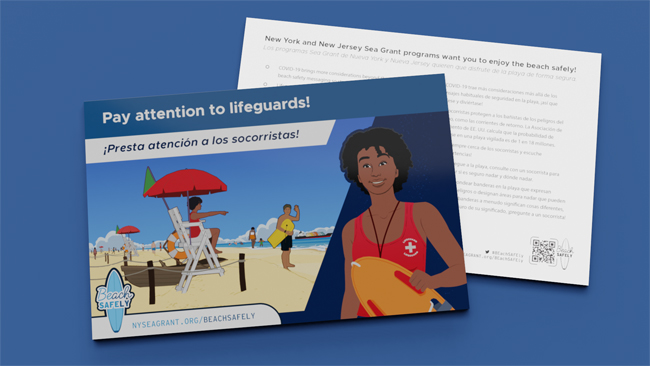
Throughout the summer, #BEachSAFEly and "Pay Attention to lifeguards!" ...
• Lifeguards protect beachgoers from ocean hazards, such as rip currents. The U.S. Lifesaving Association calculates the chance of drowning at a lifeguarded beach to be 1 in 18 million.
• Always swim near lifeguards and listen to their warnings!
• When you arrive at the beach, check with a lifeguard to determine if it is safe to swim and where to swim.
• Flags may be flown at the beach that express different hazards or designate swimming areas that may change; flags often mean different things, if you are unsure of their meanings, ask a lifeguard!
Week 3: "Wear Sun Protection" | back to top
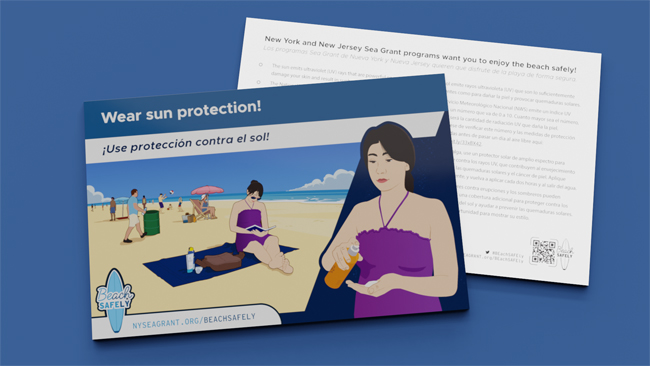
Remember to "Grab Your Sunscreen Before You Go," and #BEachSAFEly this summer ...
• The sun emits ultraviolet (UV) rays that are powerful enough to damage your skin and result in sunburn!
• The National Weather Service (NWS) issues a daily UV Index, a number ranging from 0-10. The higher the number, the greater the amount of skin damaging UV radiation. Make sure to check this number and the appropriate protective actions before you spend a day outside here.
• When you do go outside, use a broad-spectrum sunscreen to protect against UV rays, which contribute to premature aging, sunburn, and skin cancer. Apply generously and reapply every two hours and/or when you get out of the water.
• Rash guards and hats can provide added coverage to protect against the sun's harmful rays and help prevent sunburn. And an opportunity to show off your style.
Week 4: "Rock the Jacket" | back to top
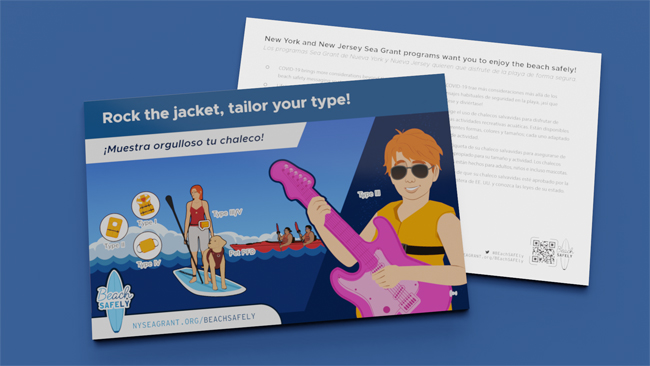
When on the water this summer, here are some #BEachSAFEly tips to help you “Rock the jacket, tailor your type!” …
• Lifejackets are required when you are enjoying various water recreational activities! They are available in different shapes, colors, and sizes; each tailored to the type of activity
• Read your lifejacket’s label to be sure it is appropriate for your size and activity. Lifejackets are made for adults, children, and even pets!
• Make sure your life jacket is U.S. Coast Guard-approved and know your state laws.
Week 5: "Stay Dry When Waves Are High" | back to top
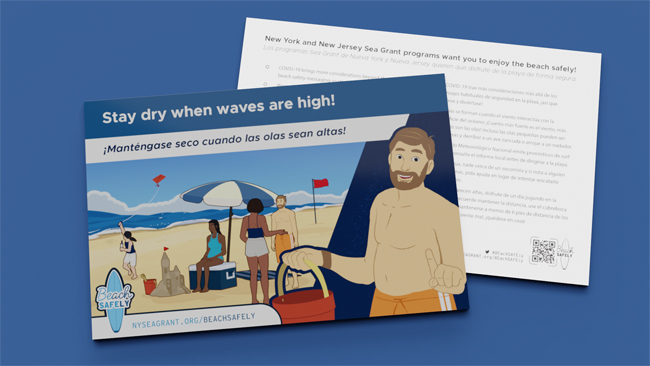
Be aware this summer, #BEachSAFEly and "Stay dry when waves are high" …
• Waves form as the wind interacts with the ocean’s surface; the stronger the wind, the larger the waves! Even small waves can be powerful and knock over a wader or toss around a swimmer.
• The U.S. National Weather Service issues daily surf forecasts; check your local report before you head to the beach.
• If you go into the water, swim near a lifeguard and if you notice someone in trouble, call for help rather than attempting to rescue them yourself.
• If the waves look high, enjoy a day playing on the sand.
Week 6: "Shoreline Rescue" | back to top
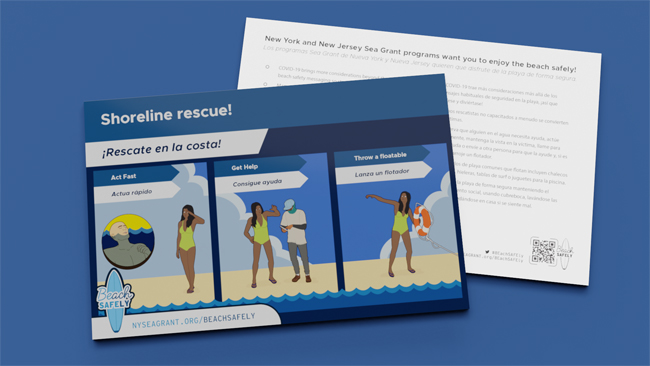
As the summer season carries on, remember these #BEachSAFEly tips if the need arises for you to assist in a "Shoreline rescue" ...
• Many untrained rescuers often become victims themselves.
• If you notice someone in the water who needs assistance, act quickly, maintain sight of the victim, call for help or send someone else to get help, and if possible throw a floatable to them.
• Common beach items that float include life jackets, coolers, boogie boards, surfboards, or pool toys.
Week 7: "Don’t Let Your Trash Become Marine Debris" | back to top

While enjoying your summer, #BEachSAFEly and "Don’t Let Your Trash Become Marine Debris" …
• Marine debris is any manufactured solid material that is intentionally or unintentionally disposed of or abandoned into the marine system. Learn more information here: www.marinedebris.noaa.gov.
• Marine debris can originate at the beach or make its way into the ocean from inland areas being carried by water or wind; it persists in the marine environment and causes harm to plants and animals.
• It is important while at the beach to dispose of waste properly. If you use disposable items while at the beach, please deposit all trash and recyclable material in the appropriate bins placed along the beach.
• If you cannot find a bin, take your trash with you and dispose of it at home. Trash left on the beach is not only unsightly, but can be a hazard to wildlife if they ingest or get entangled in it.
• You can avoid trash completely by bringing reusable items.
• Make sure you take everything that you brought with you and dispose of your trash in appropriate receptacles.
Week 8: "Be a Water Watcher" | back to top
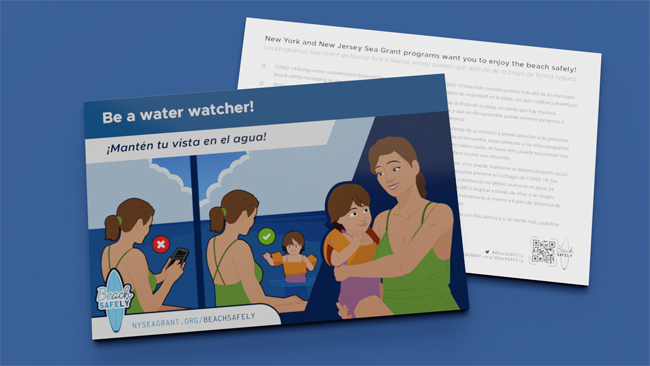
Cooling off this weekend? #BEachSAFEly and "Be a Water Watcher" …
• While you enjoy the beach, remember there are many hazards and a nice day can quickly turn dangerous or even deadly!
• Be aware of your surroundings and pay attention to those you are with, particularly small children or those who are poor swimmers. By doing this, you can react more quickly if a situation occurs.
• Always swim near a lifeguard and listen to their warnings. When you arrive at the beach, check with a lifeguard if you are unsure where you can or if it is safe to swim. ?
• Flags may be flown at the beach that express different hazards or designate swimming areas that may change from time to time; if you are unsure of their meanings, ask a lifeguard! ?
• Lifeguards work to protect beachgoers from ocean-related hazards, such as rip currents. In fact, according to the United States Lifesaving Association, the chance of drowning at a lifeguarded beach is 1 in 18 million.
Week 9: "Never Dig Deeper Than Your Knees" | back to top
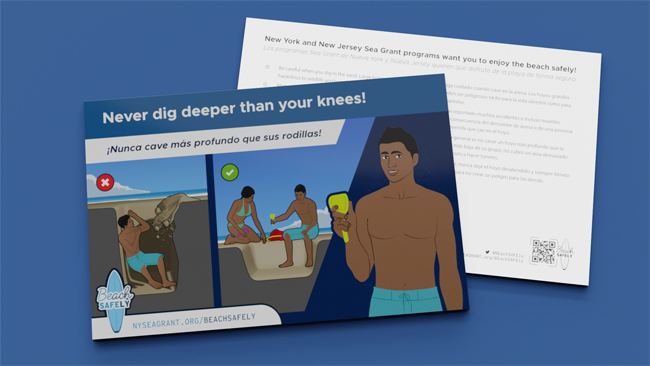
While enjoying your summer, #BEachSAFEly and "Never Dig Deeper Than Your Knees" ...
• Be careful when you dig in the sand. Large holes can be hazardous to wildlife and beach goers alike.
• Many accidents and even deaths have been reported as a result of sand collapsing or an unsuspecting person falling into the hole.
• The rule of thumb is not to dig a hole deeper than the shortest person in your group, not to cover an area too wide, and never create tunnels.
• Lastly, never leave the hole unattended and always fill it back in, as to not create a hazard to others.
Week 10: Poster — "10 Tips to Help You #BEachSAFEly" | back to top
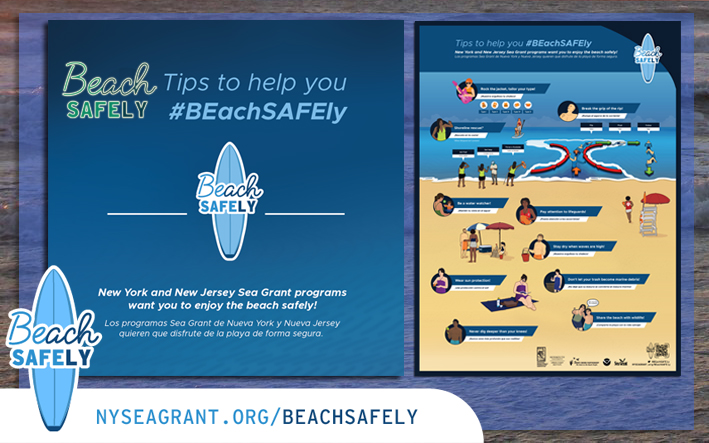
A revised Sea Grant poster illustrates that when you’re spending time outside, don't forget some key #BEachSAFEly tips.
These include ...
• "Be a Water Watcher", "Be aware of the "shoreline rescue'", "Pay Attention to Lifeguards"
• While on or in the water, “Rock the Jacket” and “Break The Grip of the Rip”
• While at the beach, “Wear Sun Protection”, “Don’t Let Your Trash Become Marine Debris”, “Share the Beach with Wildlife”, “Stay Dry When the Waves are High”, “Never Dig Deeper Than Your Knees”
You can check out individual posts about each of these tips from earlier this summer in the Summer 2023 posts above.
Summer 2022 | back to top
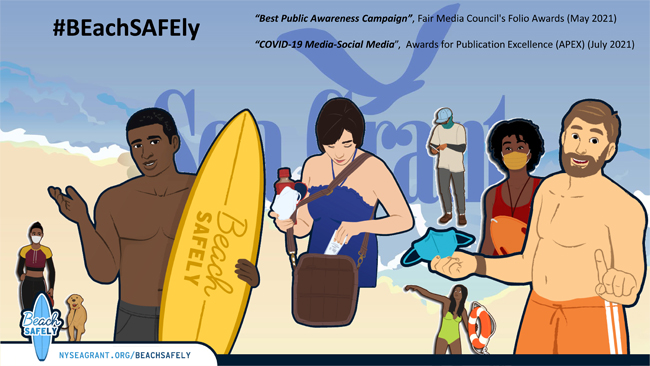
Stony Brook, NY, June 27 - July 7, 2022 - Sea Grant's #BEachSAFEly launches its third summer season with a two week long collection of social media posts being shared on Facebook, Twitter and Instagram by New York Sea Grant as well as other Sea Grant programs within the Great Lakes network.
This season’s #BEachSAFEly posts, which focus on standard "ocean hazards" tips and are distributed by Sea Grant programs throughout the Great Lakes region, are based on ones from Sea Grant programs of the Northeast and Mid-Atlantic regions sent during the 2020 and 2021 summer seasons of this award-winning (Folio Award; APEX) campaign.
Navigate to ... Day 1 | Day 2 | Day 3 | Day 4 | Day 5 | Day 6
Day 1: Stay dry when waves are high | back to top
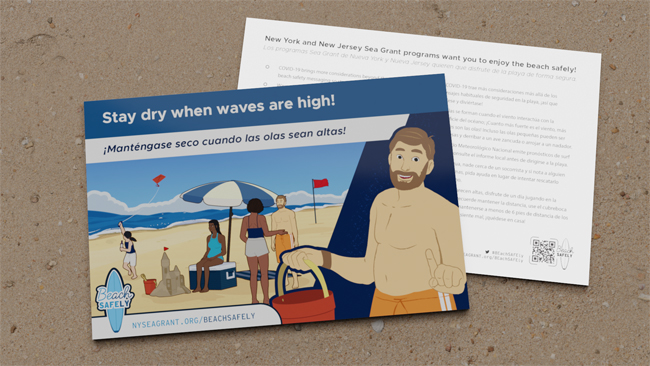
Be aware this summer, #BEachSAFEly and "Stay dry when waves are high" …
— The stronger the wind, the larger the waves! Even small waves can be powerful and knock over a wader or toss around a swimmer.
— The U.S. National Weather Service issues daily surf forecasts. Check your local report before you head to the beach.
— Beaches may also use colored flags to show whether the water is safe for swimming. If you’re not sure what they mean, ask a lifeguard or park attendant.
— If it’s safe to swim, stay near a lifeguard or pal on the beach. If you notice someone in trouble, call for help rather than attempting to rescue them yourself.
— If the waves look high, grab a kite or enjoy a day playing on the sand!
Day 2: Grab your sunscreen before you go | back to top
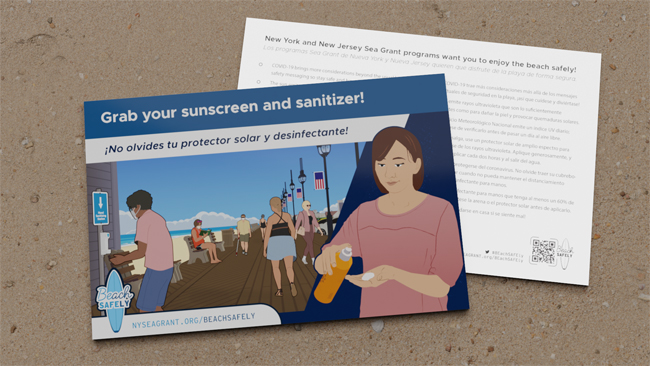
Be aware this summer, #BEachSAFEly and "Grab your sunscreen before you go!" …
— The sun’s ultraviolet (UV) rays are powerful enough to damage your skin and can result in sunburn, wrinkles, or skin cancer!
— The U.S. National Weather Service (NWS) issues a daily UV Index; make sure to check before you spend a day outside.
— When you go outside, use a broad-spectrum sunscreen to protect against UV rays. Apply generously and reapply every two hours and/or when you get out of the water. Aim for the shade, and wear a hat and sunglasses to protect your scalp and eyes.
Day 3: Be mindful of the water, lifeguards | back to top
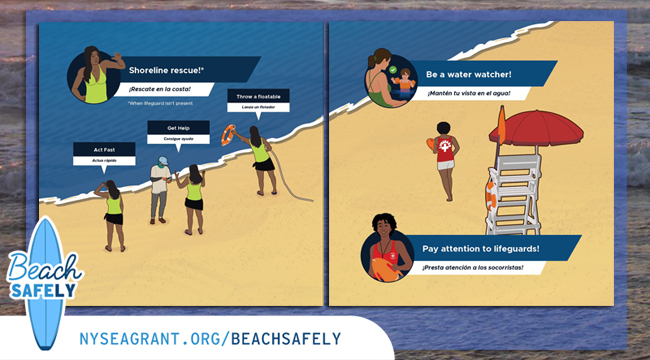
Cooling off this weekend? #BEachSAFEly and ...
— "Be a water watcher": Paying attention can keep a nice day at the beach from turning dangerous or even deadly. Be aware of your surroundings and pay close attention to the people you’re with, especially small children or inexperienced swimmers.
— “Be aware of the ‘shoreline rescue’”: If you notice someone in trouble in the water: (1) Stay on shore — going into the water could turn you into another person who needs to be rescued; (2) Keep the person in sight and call for help or send someone else to get help; (3) If possible, throw a floatable to them. Common beach items that float include life jackets, coolers, boogie boards, surfboards, or pool toys.
— “Pay attention to lifeguards”: Always swim near a lifeguard, if available, and listen to their warnings. Beaches may use colored flags to show whether the water is safe for swimming. If you’re not sure what they mean, ask a lifeguard or park attendant.
If your local beach doesn’t have lifeguards, advocate for hiring them. According to The U.S. Lifesaving Association the chance of drowning at a lifeguarded beach is only 1 in 18 million.
Learn more: Great Lakes Water Safety Consortium.
Day 4: Break the grip of the rip | back to top
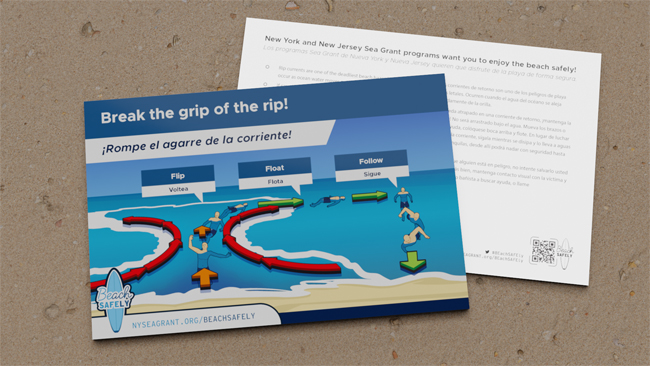
While swimming this summer, #BEachSAFEly and "Break the grip of the rip" ...
— Rip currents are one of the deadliest beach hazards. They occur as ocean water moves swiftly away from the shore.
— If caught in a rip current, remain calm! You will not be pulled underwater. Rather than fighting against the current, FLIP onto your back, FLOAT while you wave or call for help, and FOLLOW the current as it weakens and takes you to calmer waters. Then you can swim safely to shore.
— If you notice someone in danger, do not try to save them by yourself. Keep them in sight and call 911 or send another beachgoer to get help.
Day 5: Rock the jacket, tailor your type | back to top
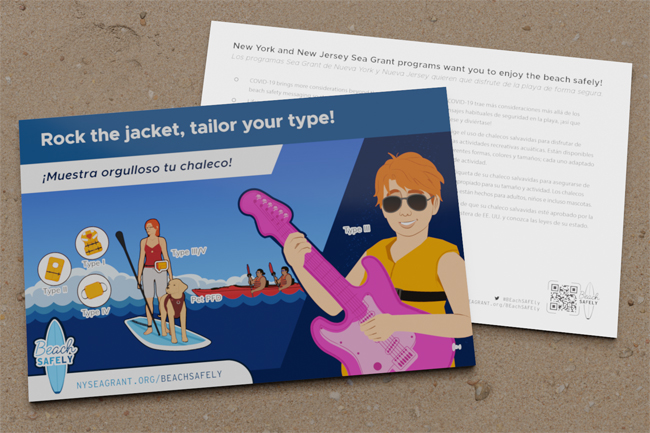
When on the water this summer, here are some #BEachSAFEly tips to help you “Rock the jacket, tailor your type!” ...
— Life jackets are essential to staying safe while on or near the water. They are required when you are enjoying various activities like boating, kayaking, and paddle boarding.
— Life jackets can be made for adults, children, and even pets! They are available in different shapes, colors, and sizes, and each is tailored to a specific type of activity. Read your life jacket’s label to make sure it is appropriate for your size and activity.
— Make sure your life jacket is U.S. Coast Guard-approved and know your state laws about when and how to wear them.
Day 6: Be mindful of marine debris | back to top
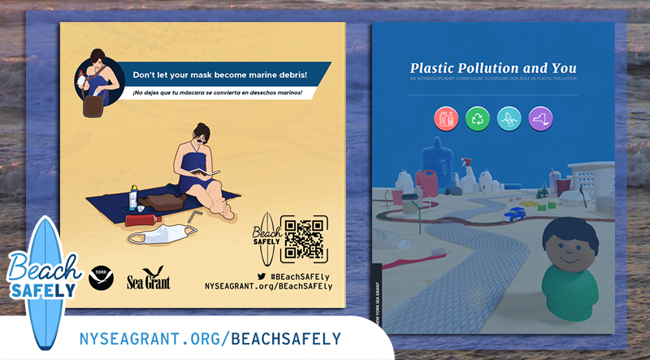
While enjoying your summer, #BEachSAFEly and "Be Mindful of Marine Debris" ...
— Don’t create marine debris! Make sure nothing you brought to the beach blows away — litter can quickly become #marinedebris. This debris can linger in the water or along the shoreline and cause harm to plants and animals.
— When you leave, take everything that you brought with you and dispose of your trash in appropriate containers where the wind can’t blow it back out.
For additional information, visit NOAA Marine Debris or www.nyseagrant.org/marinedebris.
Summer 2021 | back to top
Stony Brook, NY, May 19 - September 1, 2021 - Sea Grant's #BEachSAFEly, which today launched its second summer season in mid-May, was named "Best Public Awareness Campaign" by Fair Media Council's Folio Awards. Later in the summer, it also received a national award from APEX, Awards for Publication Excellence.
The summer-long campaign — a partnership between New York Sea Grant and the New Jersey Sea Grant Consortium that began with a COVID-19 Rapid Response grant from the National Oceanic and Atmospheric Administration’s National Sea Grant College Program — focuses on standard "ocean hazards" tips as well as general safety and health concerns related to the COVID-19 pandemic.
Navigate to ... Week 1 | Week 2 | Week 3 | Week 4 | Week 5 | Week 6 | Week 7 | Week 8 | Week 9 | Week 10 | Week 11 | Week 12 | Week 13 | Week 14 | Week 15 | Week 16
Week 1: Award-Winning Campaign | back to top
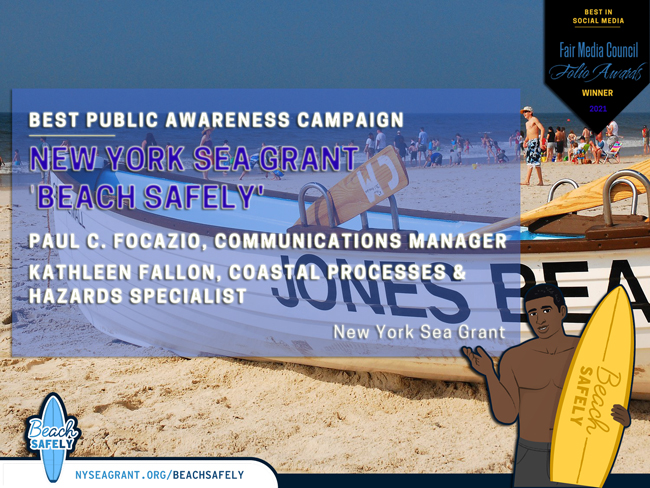
Sea Grant's #BEachSAFEly was named "Best Public Awareness Campaign" by Fair Media Council's Folio Awards.
This marks the third time in eight years that the Fair Media Council has bestowed the honor to Sea Grant in this social media category. In 2020, Sea Grant was recognized for its "Currents Clips" limited video series and in 2014 it was applauded for its collection of science-based social media posts released before, during, and after Superstorm Sandy.
Week 2: Scene — "Rock the jacket, tailor your type!" | back to top

When on the water this summer, here are some #BEachSAFEly tips to help you “Rock the jacket, tailor your type!” ...
— Life jackets are required when you are enjoying various water recreational activities! They are available in different shapes, colors, and sizes; each tailored to the type of activity
— Read your life jacket’s label to be sure it is appropriate for your size and activity. Lifejackets are made for adults, children, and even pets!
— Make sure your life jacket is U.S. Coast Guard-approved and know your state laws
Week 3: Snapshot of #BEachSAFEly: Season 1 | back to top
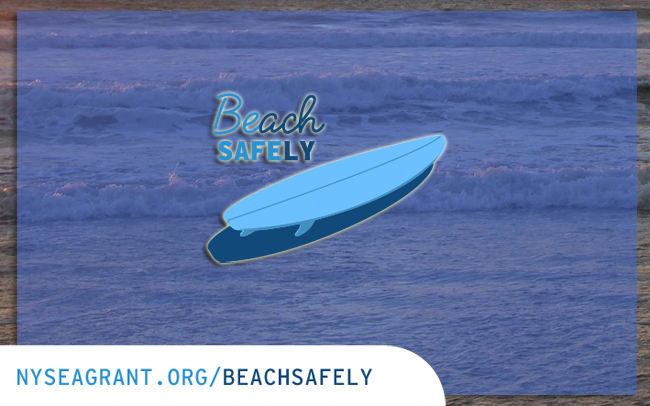
Over a nine-week period between July and September in 2020, #BEachSAFEly posts reached more than 9,345 stakeholders and received 738 engagements on Facebook and 22,724 impressions and 653 engagements on Twitter.
Overall, the average engagement rate for Season 1 of the #BEachSAFEly campaign was almost 10 times higher than what is considered "high" engagement.
Week 4: Outdoor Restrictions Revised | back to top
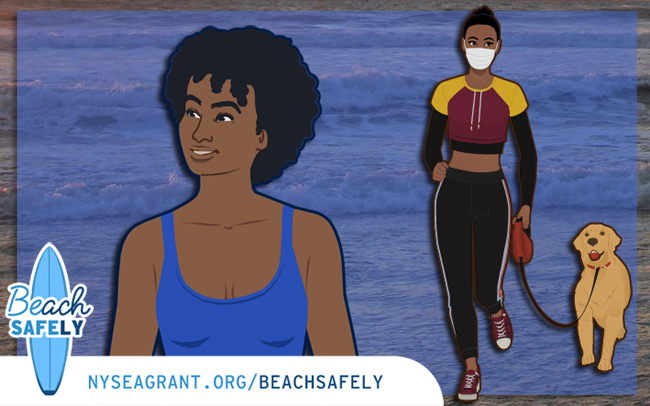
Going to the beach this summer for a jog, swim or some fun in the sun?
While outdoor restrictions related to the COVID-19 pandemic have recently changed (see the U.S. Centers for Disease Control and Prevention for the latest guidance at www.cdc.gov/coronavirus).
Sea Grant reminds you to #BEachSAFEly so you can stay safe and have fun!
Week 5: Scene — "Be mindful of marine debris!" | back to top
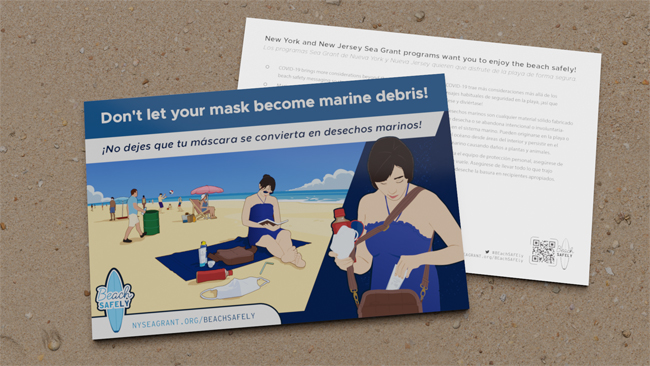
While enjoying your summer, #BEachSAFEly and "Be Mindful of Marine Debris" ...
— Marine debris is any manufactured solid material that is intentionally or unintentionally disposed of or abandoned into the marine system. It can originate at the beach or make its way into the ocean from inland areas and persist in the marine environment causing harm to plants and animals.
— If you bring a mask or any other personal protection equipment with you, be sure that it doesn’t blow away after you remove it. Make sure you take everything that you brought with you and dispose of your trash in appropriate receptacles.
And remember that while outdoor restrictions related to the COVID-19 pandemic have changed, check with the U.S. Centers for Disease Control and Prevention (as well as with your state) for latest national and local guidance. More at: www.cdc.gov/coronavirus.
Week 6: Scene — "Shoreline Rescue!" | back to top
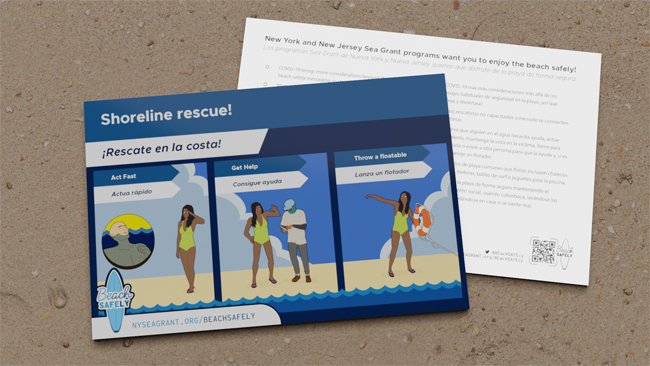
As we officially begin this summer season, remember these #BEachSAFEly tips if the need arises for you to assist in a "Shoreline rescue" ...
— Many untrained rescuers often become victims themselves.
— If you notice someone in the water who needs assistance, act quickly, maintain sight of the victim, call for help or send someone else to get help, and if possible throw a floatable to them.
— Common beach items that float include life jackets, coolers, boogie boards, surfboards, or pool toys.
Week 7: Scene — "Pay Attention to Lifeguard!" | back to top
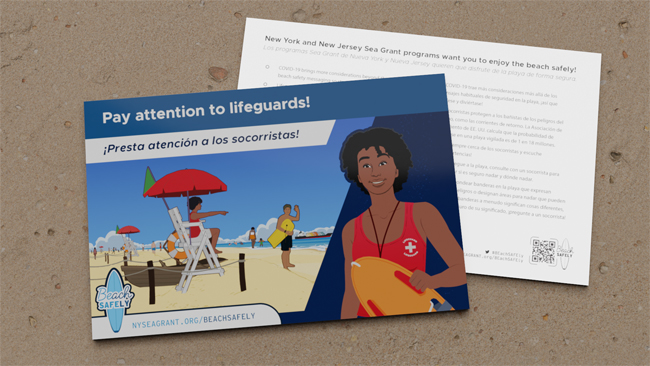
#BEachSAFEly and "Pay attention to lifeguards!" ...
— Lifeguards protect beachgoers from ocean hazards, such as rip currents. The U.S. Lifesaving Association calculates the chance of drowning at a lifeguarded beach to be 1 in 18 million: www.usla.org/page/Beachsafety.
— Always swim near lifeguards and listen to their warnings!
— When you arrive at the beach, check with a lifeguard to determine if it is safe to swim and where to swim.
— Flags may be flown at the beach that express different hazards or designate swimming areas that may change; flags often mean different things, if you are unsure of their meanings, ask a lifeguard!
Week 8: Scene — "Stay Social, Be Distant!" | back to top
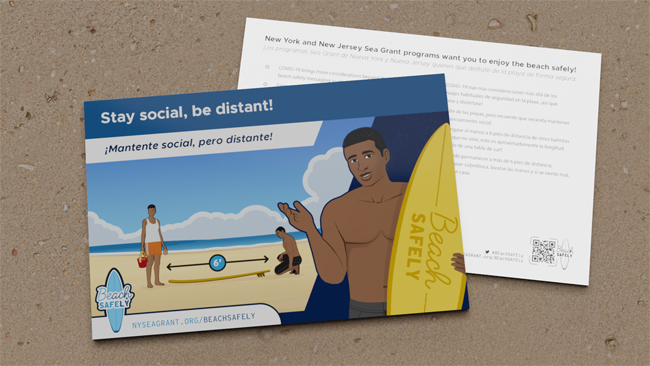
Going to the beach this summer?
— Outdoor restrictions related to the COVID-19 pandemic have changed this season, so be sure to check the latest guidance from the CDC, www.cdc.gov/coronavirus.
— Requirements in New York and New Jersey may vary, so also see www.governor.ny.gov/keywords/coronavirus and covid19.nj.gov.
Sea Grant reminds you to #BEachSAFEly while you stay social so that you can stay safe and have fun!
Week 9: First-Half Review — Scenes 1-5 | back to top
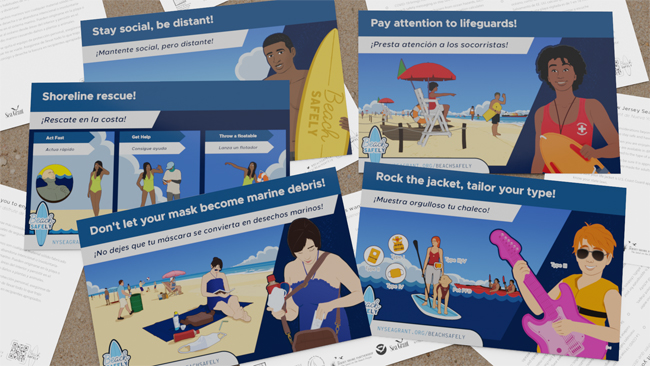
This summer, Sea Grant programs in New York and New Jersey are building on the success of their 2020 all-virtual #BEachSAFEly campaign by making the messages and images available through individual postcards.
Also, posters are available to beach communities, public venues, and other community organizations. Beginning in early August, we’ll start revealing slices from this new poster, “9 Tips to Help You #BEachSAFEly” on Instagram, www.instagram.com/newyorkseagrant, where it will be completed in late August and then also debut on Facebook, www.facebook.com/nyseagrant, as well as Twitter, www.twitter.com/nyseagrant.
Be sure to follow us on our social media channels to see more of this series in your news feeds!
Week 10: Scene — "Break the Grip of the Rip!" | back to top

While swimming this summer, #BEachSAFEly and "Break the grip of the rip" ...
— Rip currents are one of the deadliest beach hazards. They occur as ocean water moves swiftly away from the shore.
— If caught in a rip, remain calm! You will not be pulled under water. Wave or call for help, flip onto your back and float; rather than fighting against the current, follow it as it dissipates and takes you to calmer waters. Then, you can swim safely to shore.
— If you notice someone in danger, do not try to save them by yourself – rather, maintain visual contact with the victim and send another beachgoer to get help, or call 9-1-1.
NYSG offers its rip current resources at www.nyseagrant.org/ripcurrents.
Week 11: Scene — "Be a Water Watcher!" | back to top

Cooling off this weekend? #BEachSAFEly and "Be a water watcher" ...
— While you enjoy the beach, remember there are many hazards and a nice day can quickly turn dangerous or even deadly!
— Be aware of your surroundings and pay attention to those you are with, particularly small children or those who are poor swimmers. By doing this, you can react more quickly if a situation occurs.
Week 12: Scene — "Grab Your Sunscreen Before You Go!" | back to top

Remember to "Grab Your Sunscreen Before You Go," and #BEachSAFEly this summer ...
— The sun emits ultraviolet rays that are powerful enough to damage your skin and result in sunburn!
— U.S. National Weather Service (NWS) issues a daily UV Index; make sure to check before you spend a day outside.
— When you go outside, use a broad-spectrum sunscreen to protect against UV rays. Apply generously and reapply every two hours and when you get out of the water.
Also, beginning this Friday (August 6th), we’ll start revealing slices from our new poster, “9 Tips to Help You #BEachSAFEly” on Instagram, www.instagram.com/newyorkseagrant, where it will be completed by Wednesday, August 25th and then also debut on Facebook, www.facebook.com/nyseagrant, as well as Twitter, www.twitter.com/nyseagrant.
Week 13: Scene — "Stay Dry When Waves Are High!" | back to top

Be aware this summer, #BEachSAFEly and "Stay dry when waves are high" ...
— Waves form as the wind interacts with the ocean’s surface; the stronger the wind, the larger the waves! Even small waves can be powerful and knock over a wader or toss around a swimmer.
— The U.S. National Weather Service issues daily surf forecasts; check your local report before you head to the beach.
— If you go into the water, swim near a lifeguard and if you notice someone in trouble, call for help rather than attempting to rescue them yourself.
— If the waves look high, enjoy a day playing on the sand.
Also, since August 6th we've been revealing slices from our new poster, “9 Tips to Help You #BEachSAFEly” on Instagram, www.instagram.com/newyorkseagrant, where it will be completed by Wednesday, August 25th and then also debut on Facebook, www.facebook.com/nyseagrant, as well as Twitter, www.twitter.com/nyseagrant.
Week 14: #BEachSAFEly — A Two-Time Award-Winning Campaign | back to top

The summer-long #BEachSAFEly campaign, a partnership between NYSG and the New Jersey Sea Grant Consortium, has received both a national and regional award for providing both standard “ocean hazards” tips as well as general safety and health concerns related to the COVID-19 pandemic.
Also, since August 6th we've been revealing slices from our new poster, “9 Tips to Help You #BEachSAFEly” on Instagram, www.instagram.com/newyorkseagrant, where it will be completed by Wednesday, August 25th and then also debut on Facebook, www.facebook.com/nyseagrant, as well as Twitter, www.twitter.com/nyseagrant.
Week 15: #BEachSAFEly — “9 Tips to Help You #BEachSAFEly” Poster | back to top
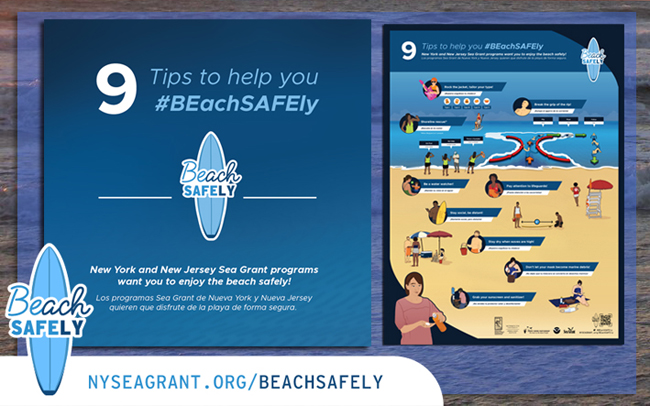
We're unveiling “9 Tips to Help You #BEachSAFEly,” a new poster from the award-winning summer-long #BEachSAFEly campaign.
Content comes from the standard “ocean hazards” tips as well as general safety and health concerns related to the COVID-19 pandemic that we've been offering over the last two seasons.
You can also check out slices from the new poster on Instagram, www.instagram.com/newyorkseagrant; The poster is also displayed in its entirety on Facebook and Twitter.
In addition to making this poster available to beach communities, public venues, and other community organizations this season, Sea Grant programs in New York and New Jersey are building on the success of their 2020 all-virtual #BEachSAFEly campaign by making the messages and images available through individual postcards.
Week 16: Second-Half Review — Scenes 6-9 | back to top
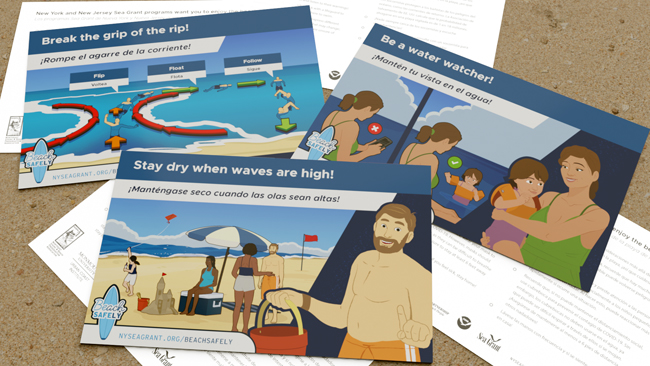
This summer, Sea Grant programs in New York and New Jersey have built on the success of their 2020 all-virtual #BEachSAFEly campaign by making the messages and images available through individual postcards. Also, posters are available to beach communities, public venues, and other community organizations.
Check out the posts above to learn more about the series’ nine postcard scenes, which have also been incorporated into the poster design.
Summer 2020 | back to top
Stony Brook, NY, July 16 - September 10, 2020 - This summer, New York Sea Grant (NYSG) and New Jersey Sea Grant Consortium (NJSGC) want you to still enjoy the beach safely while you be safe!
COVID-19 brings more considerations beyond the usual beach safety messaging. So, starting in early July and running through Labor Day Week in September, our Sea Grant programs are going to be launching a new social media graphic each week to remind beachgoers to stay safe and have fun!
Navigate to ... Week 1 | Week 2 | Week 3 | Week 4 | Week 5 | Week 6 | Week 7 | Week 8 | Week 9
Week 1: Stay Social, Be Distant! | English PDF | Spanish PDF | back to top
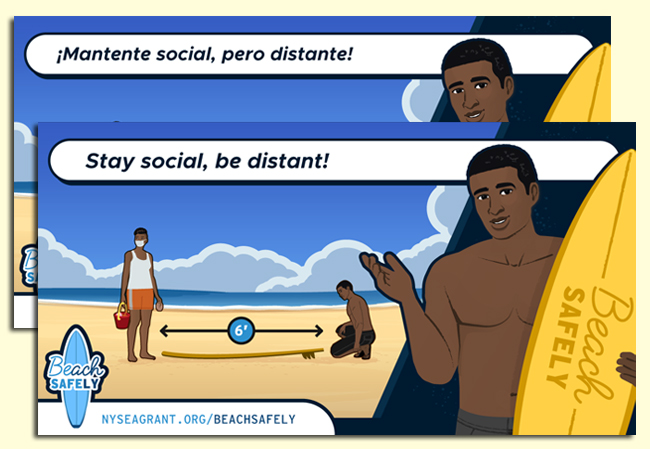
This summer, the beaches are open and you should enjoy them! Just remember that you still need to practice social distancing – embrace your personal space.
Stay at least 6 feet apart from other beach goers that you didn’t come with; this is about the average length of a surfboard, two boogie boards, a bit more than an beach towel’s length, or three beach chairs – you could even measure based on your beach umbrella’s pole!
When you’re walking around the beach, to and from the parking lot or other facilities, or if you can’t stay more than 6 feet apart from others, remember to wear your mask. Frequently wash or sanitize your hands – and if you feel sick, stay home.
Week 2: Break The Grip of the Rip | English PDF | Spanish PDF | back to top
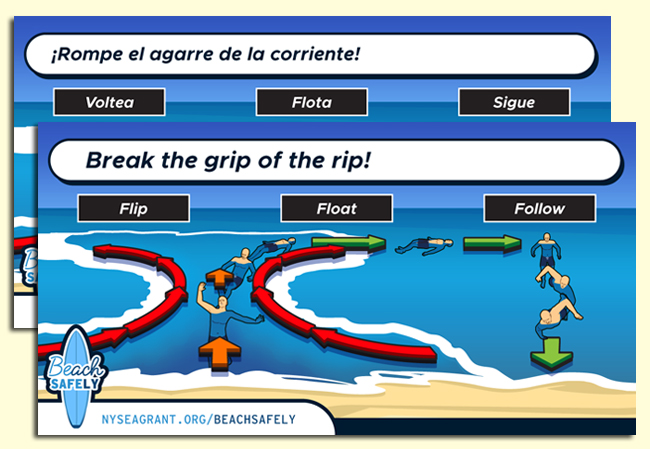
Rip currents are one of the deadliest beach hazards. They occur as ocean water moves swiftly away from the shore.
If caught in a rip, remain calm! Wave or call for help, flip onto your back and float, rather than fighting against the current, and follow it as it takes you to calmer waters where it dissipates and you can swim safely to shore.
If you notice someone else in danger, do not try to save them yourselves - rather maintain visual contact with the victim and send another beach goer to get help, or call 9-1-1.
NYSG offers its rip current resources at www.nyseagrant.org/ripcurrents.
Remember to enjoy the beach safely this summer by (1) avoiding physical contact with others (outside of those who you came with); (2) bringing and wearing your mask when you’re not sitting on your towel or in the water; (3) washing your hands; and (4) if you feel sick, stay home!
Week 3: Shoreline Rescue | English PDF | Spanish PDF | back to top
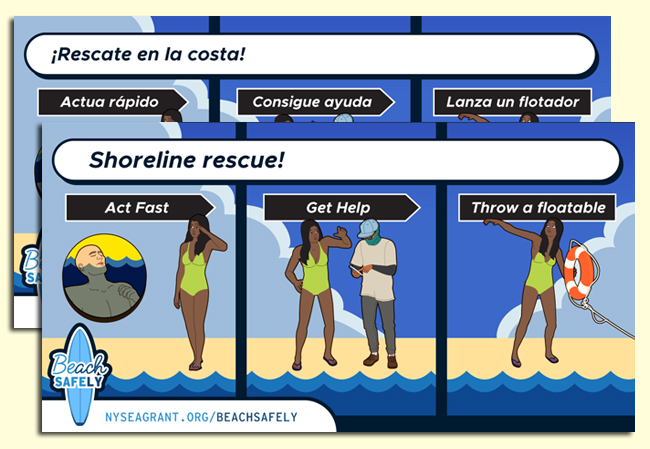
Many rescuers often become victims themselves, if you notice someone in the water who needs assistance, follow these steps to assist them while you stay safe!
Act quickly, maintain sight of the victim, call for help or send someone else to get help, and if possible throw a floatable to them.
Common beach items that float include life jackets, coolers, boogie boards, surfboards, or pool toys.
Remember to enjoy the beach safely this summer by (1) avoiding physical contact with others (outside of those who you came with); (2) bringing and wearing your mask when you’re not sitting on your towel or in the water; (3) washing your hands; and (4) if you feel sick, stay home!
Week 4: Grab your sunscreen and sanitizer! | English PDF | Spanish PDF | back to top
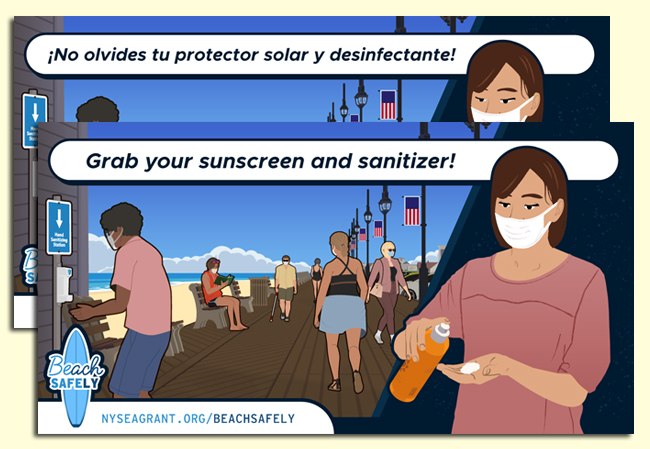
The sun emits ultraviolet (UV) rays which are powerful enough to damage your skin and result in sunburn!
The National Weather Service (NWS) issues a daily UV Index, a number ranging from 0-10; the higher the number, the greater amount of skin damaging UV radiation. Make sure to check this number and the appropriate protective actions before you spend a day outside.
When you do go outside, use a broad spectrum sunscreen to protect against UV rays, which contribute to premature aging, sunburn, and skin cancer. Apply generously and reapply every two hours and/or when you get out of the water.
This summer, in addition to protecting yourself from the sun, remember to protect yourself from COVID-19. Don’t forget to bring any extra safety precautions such as your mask, which should be worn when you can’t social distance, and plenty of hand sanitizer to apply often.
To increase effectiveness, your hand sanitizer should be at least 60% alcohol and wipe any sand or sunscreen off before applying.
Remember to enjoy the beach safely this summer by (1) avoiding physical contact with others (outside of those who you came with); (2) bringing and wearing your mask when you’re not sitting on your towel or in the water; (3) washing your hands; and (4) if you feel sick, stay home!
Week 5: Be a water watcher! | English PDF | Spanish PDF | back to top
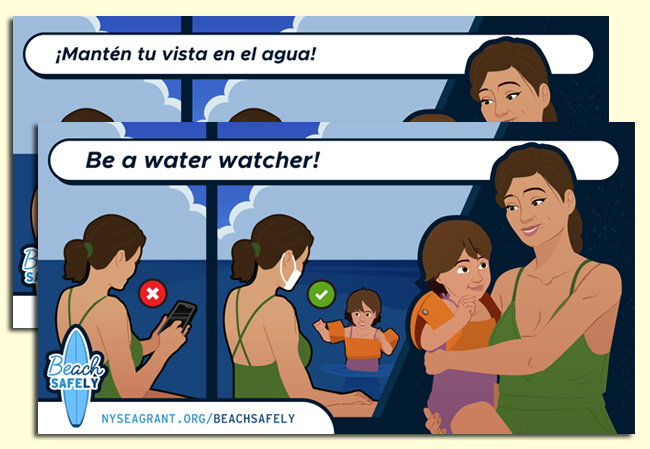
While you enjoy the beach, remember there are many hazards and a nice day can quickly turn dangerous or even deadly!
Be aware of your surroundings and pay attention to those you are with, particularly small children or those who are poor swimmers. By doing this, you can react more quickly, if a situation were to occur.
Remember to enjoy the beach safely this summer by (1) avoiding physical contact with others (outside of those who you came with) - stay at least 6 feet away from fellow beach goers and swimmers; (2) bringing and wearing your mask when you’re not sitting on your towel or in the water. however, masks should not be worn in the water, as they can be difficult to breathe through if they get wet; (3) washing/sanitizing your hands; and (4) if you feel sick, stay home!
Week 6: Stay dry when waves are high! | English PDF | Spanish PDF | back to top
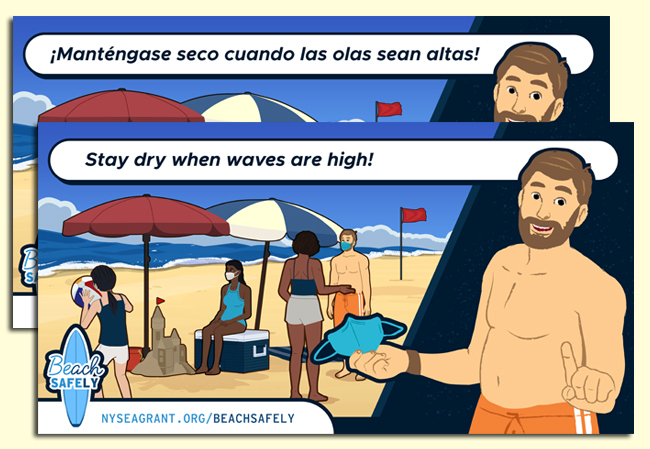
Waves form as the wind interacts with the ocean’s surface; the stronger the wind becomes, the larger the waves get! Even smaller waves can be very powerful and easily knock over a water "wader" or toss around and disorient a swimmer.
The National Weather Service issues daily surf forecasts. Be sure to check your local report before you head to the beach.
If you do go into the water, always swim near a lifeguard and if you notice someone in trouble, remember to call for help rather than attempting to perform a rescue yourself.
If the waves look high, enjoy a day playing on the sand; but remember to: (1) avoid physical contact with others (outside of those who you came with) - stay at least 6 feet away from fellow beach goers and swimmers; (2) bring and wear your mask when you’re not sitting on your towel or in the water. however, masks should not be worn in the water, as they can be difficult to breathe through if they get wet; (3) wash/sanitize your hands; and (4) if you feel sick, stay home!
Week 7: Don’t let your mask become marine debris! | English PDF | Spanish PDF | back to top
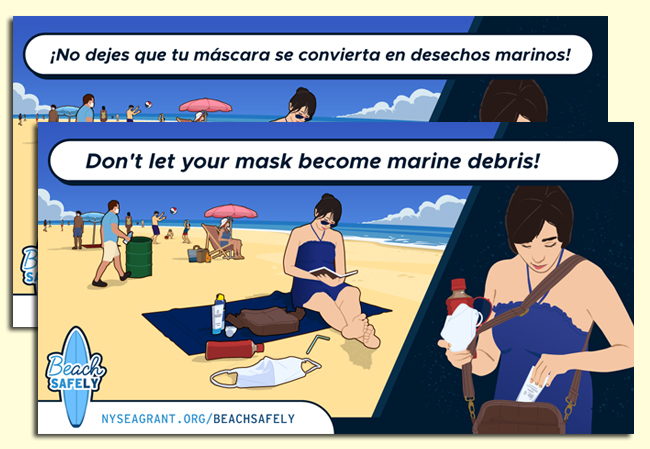
Marine debris, as defined by NOAA's Marine Debris Program, is any manufactured solid material that is intentionally or unintentionally disposed of or abandoned into the marine system. Marine debris can originate at the beach or make its way to the ocean from inland areas being carried by water or wind; it persists in the marine environment and causes harm to plants and animals.
If you remove your personal protection equipment be sure to keep an eye that it doesn’t blow away and land in the ocean. Make sure you take everything that you brought with you and dispose of your trash in appropriate receptacles.
Remember to enjoy the beach safely this summer by (1) avoiding physical contact with others (outside of those who you came with) - stay at least 6 feet away from fellow beach goers and swimmers; (2) bringing and wearing your mask when you’re not sitting on your towel or in the water. however, masks should not be worn in the water, as they can be difficult to breathe through if they get wet; (3) washing/sanitizing your hands; and (4) if you feel sick, stay home!
Week 8: Pay Attention to Lifeguards! | English PDF | Spanish PDF | back to top
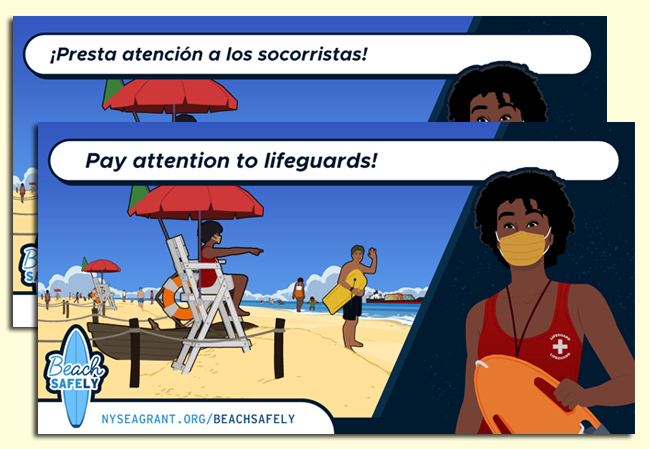
Lifeguards work to protect beachgoers from ocean-related hazards, such as rip currents. In fact, according to the United State Lifesaving Association (USLA), the chance of drowning at a lifeguarded beach to be 1 in 18 million.
Always swim near a lifeguard and listen to their warnings!
When you arrive at the beach, check with a lifeguard if you are unsure where you can or if it is safe to swim.
Flags may be flown at the beach that express different hazards or designate swimming areas that may change from time to time; if you are unsure of their meanings, ask a lifeguard!
For more, see USLA's Top 10 Beach and Water Safety Tips.
Week 9: Rock the Jacket, Tailor the Type! | English PDF | Spanish PDF | back to top
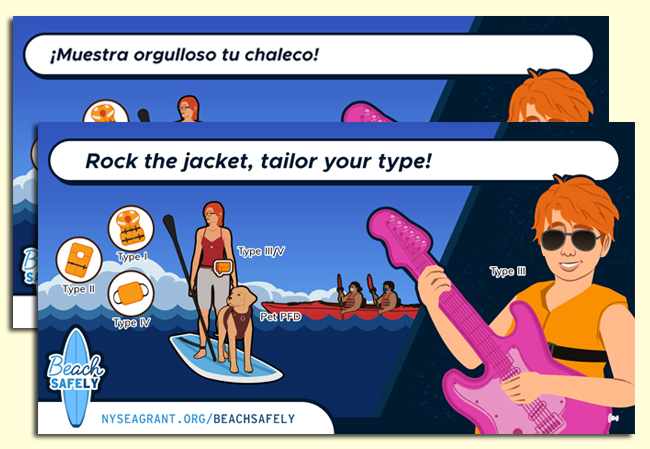
Life jackets are required when you are enjoying various water recreational activities such as boating, kayaking and paddleboarding!
Life jackets are available in different shapes, colors, and sizes; each tailored to the type of activity - U.S. Coast Guard's "Wearing Your Life jacket" and National Safe Boating Council's "Wear It"
Be sure to read your life jacket's label to be sure it is appropriate for your size and activity. Life jackets are made for adults, children, and even pets!
Make sure your life jacket is US Coast Guard approved and know your state laws - Boat U.S. Foundation's "Life Jacket Requirements (By State)"
More Info: New York Sea Grant
New York Sea Grant (NYSG), a cooperative program of Cornell University
and the State University of New York (SUNY), is one of 34 university-based
programs under the National Oceanic and Atmospheric Administration’s
National Sea Grant College Program.
Since 1971, NYSG has represented a statewide network of integrated
research, education and extension services promoting coastal community
economic vitality, environmental sustainability and citizen awareness
and understanding about the State’s marine and Great Lakes resources.
Through NYSG’s efforts, the combined talents of university scientists
and extension specialists help develop and transfer science-based
information to many coastal user groups—businesses and industries,
federal, state and local government decision-makers and agency managers,
educators, the media and the interested public.
The program maintains Great Lakes offices at Cornell University, SUNY
Buffalo, SUNY Oswego and the Wayne County Cooperative Extension office
in Newark. In the State's marine waters, NYSG has offices at Stony Brook
University in Long Island, Brooklyn College and Cornell Cooperative
Extension in NYC and Kingston in the Hudson Valley.
For updates on Sea Grant activities: www.nyseagrant.org has RSS, Facebook, Twitter, Instagram, and YouTube links. NYSG offers a free e-list sign up via www.nyseagrant.org/nycoastlines for its flagship publication, NY Coastlines/Currents, which is published quarterly. Our program also produces an occasional e-newsletter,"NOAA Sea Grant's Social Media Review," via its blog, www.nyseagrant.org/blog.